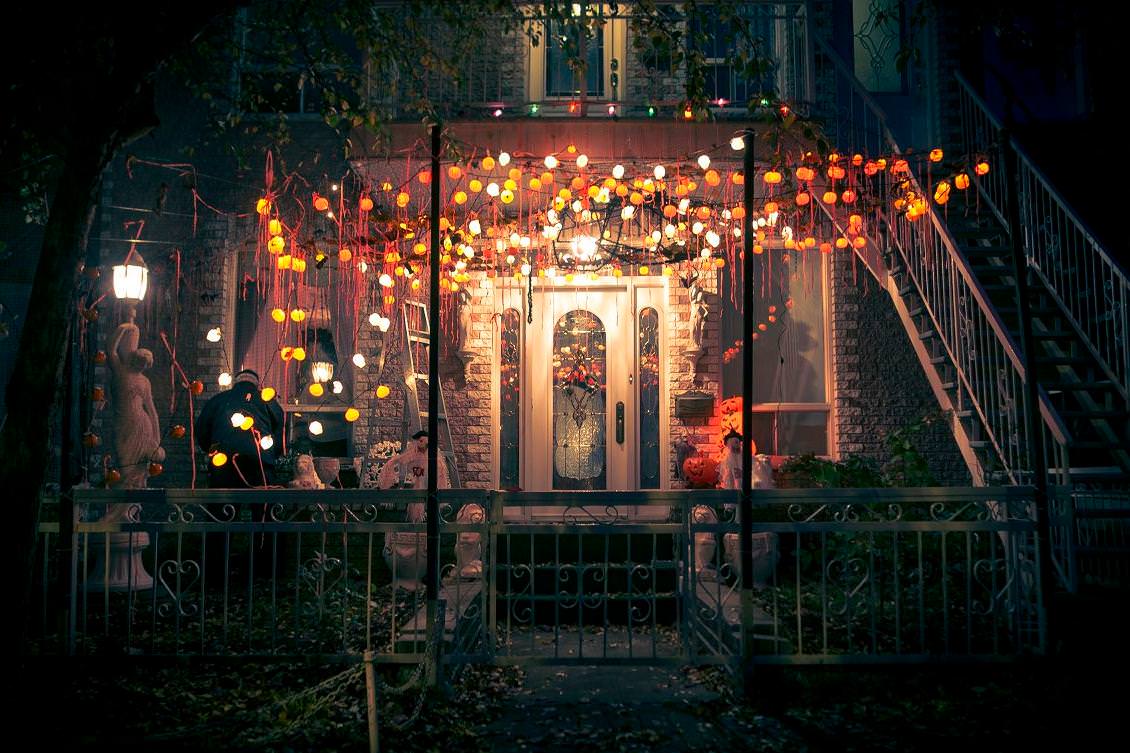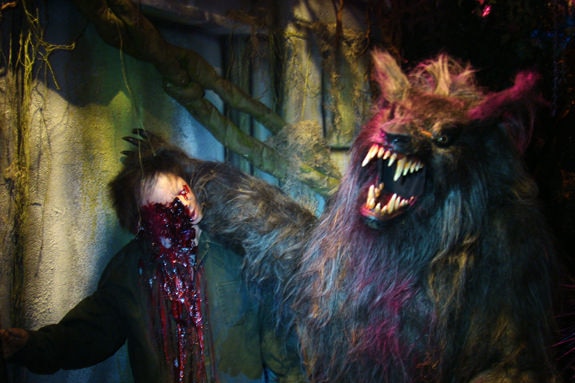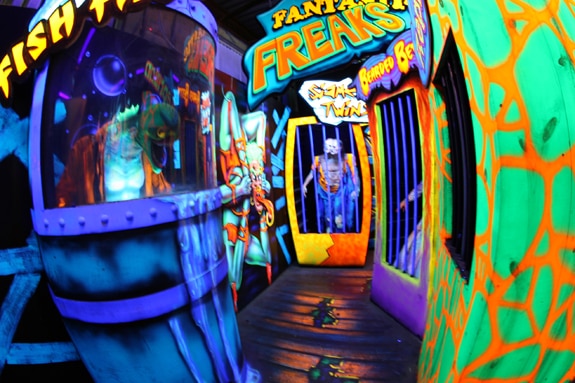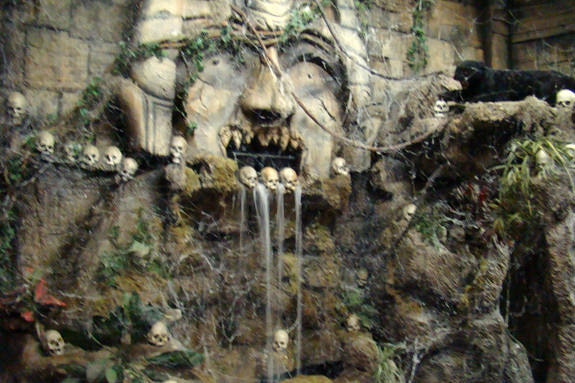Create a free profile to get unlimited access to exclusive videos, breaking news, sweepstakes, and more!
Immersive Theater, Serial Killers And Horror Movies: What Makes A Haunted House Scary?
We sit down with HauntWorld.com founder Larry Kirchner to discuss the changes in the haunted house industry, true crime's popularity amongst "haunters" and the impact social media has had on the scare business.

Halloween has evolved from a yearly holiday celebrated at October’s end into a month-long celebration of all things scary. Due to the increasing popularity—and length—of this spooky season, a haunted housing boom has occurred all over the United States.
The haunted house landscape has transformed from a predominantly DIY practice into a fully fledged and highly profitable commercial enterprise. No longer confined to low-budget thrills, haunted houses have become in some areas a kind of avant-garde, immersive theater experience—a far cry away from some creepy hayride.
Larry Kirchner is the founder of HauntWorld.com, which tracks and ranks haunted houses throughout the country in a respected yearly list. As a result, Kirchner, who has been dubbed the “King of Halloween,” has throughout his decades-long career as a haunted house expert and designer witnessed firsthand the massive changes to an industry that’s often shrouded in mystery.
As haunted houses have begun embracing true crime and real torture scenarios as inspiration, the question of what actually makes a haunted house fun—or scary—seems more prescient than ever. We chatted with Kirchner about his personal history, his thoughts on the growing Halloween scene and the limits of the new haunted house economy.
Thanks so much for joining us. Let's start with you telling us about how you got started in the haunted house industry?
LK: In like fourth grade or so I did a haunted house using blankets to make the walls. Then, later on in life I was in Saint Louis there was a big, popular haunted house. A friend encouraged me to go. I said I could get in free because I worked for the local TV station and I wanted to film it for them. I showed the guy running the haunted house the video and he loved it and asked me point blank if I would help him with it.
When Halloween ended he worked on a Christmas event and got me involved. Low and behold, he doesn't pay me. If you want to know the truth, the whole haunted house industry's backbone is not paying people. That was when all of this was getting started, it was kind of one of those businesses where you'd always be like: where'd that person go? It was a Houdini industry.
Almost like a carny culture?
Yes, very carny culture. As a matter of fact, when the haunted house industry really started to get going they started an association, which is a whole other nightmare story. The vice president actually said, “We're considered one step above carnies,” and that offended a whole bunch of people, including myself.
But anyway, the very following Halloween he asked if I would get his house up and running. I was out of high school at this point and I said sure. I was basically in the basement of this haunted house – because back then most haunted houses were in houses, like old mansions. I was working on it and I said to myself, “This guy didn't pay me, am I really that dumb?” So I just left.
On my way out I saw this flyer for another haunted house, because back then if there was one good one, like seven would open up around it—people would just have things like search lights or flyer cars. So if there was a successful one, you'd just book another one in its path. I just walked up to the guy running this other haunted house and said, “Hey, I'm a haunted house designer, do you want me to look around?”
I didn't know anything about designing a haunted house. The term haunted house designer had probably never been used in the history of mankind. I was really just a guy who was scorned. But that haunted house was really terrible—I didn't know anything but I knew it was bad. I said to him, “Trust me, I can fix this. It's Sunday, I think I can have this place up and running again by next Friday.” He hired me for $1,000.
I recruited two of my cousins and a friend who now owns one of the biggest haunted house vendors in the world. We redid the whole thing and I ended up acting in the haunted house. We ended up doing 8,000 people. The following year, I told him I think I could do better so we tore everything out and built real walls.
Were the haunted houses back then scarier than they are now?
That first house I built, it was so scary. It was so much scarier than any of my haunted houses today. My cousin who helped me build it played Jason. He helped me start HauntWorld.com. People were complaining about a horrible smell in the house: it was my cousin who hadn't taken a shower since we started. He said, “Isn't Jason dead? I'm in the dark. The people can't see me. I'm dead. I'm Jason.” That's how serious the people who worked at these were. They weren't doing it for money.
We had seven or eight people chasing people customers out of the haunted house. They would jump on top of the cars as they drove away. We chased someone off a cliff near the church once. We had real circular saws and drills. That was back when people had baseball bats and they would club up the walls. Every year we had to replace all the walls because the actors destroyed the haunted house.
So part of the reason they got less scary was because now there's a bigger concern for safety?
That's right. We didn't care about safety. There was a lot of scandal around fire marshals coming and demanding the haunted houses install sprinkler systems. It put a lot of the haunted houses out of business. And a lot of them got destroyed by actors using weapons that I would freak out if I saw them using today. You can't do these things any more. But we did it.
What are the factors that make the scariest haunted houses?
Today you have certain people that want to open a haunted house and call it an “extreme” haunted house – where they literally torture people. To me, those aren't haunted houses; they give haunted houses a bad name. Like McKamey Manor, that place will—if they continue doing what they do—eventually they'll kill someone. They've had to call ambulances because one guy's heart stopped. To me, that's not a viable attraction. You're putting people's' lives at risk by shoving things in their mouths, dropping snakes on them, waterboarding them. That's not a haunted house. That's a sick Ted Bundy fantasy. So we have to be distinct between the two.
So when we take those extreme haunts and you compare them to what was happening 30 years ago, they were still technically haunted houses—but we really didn't have rules. We didn't have people sign waivers. We weren't thinking about lawsuits.
The industry changed when inspectors and fire marshals began investigating them after realizing we weren't paying taxes or using sprinkler systems. It killed about 70% of the haunted houses that existed in the '90s. It started transitioning from an industry where you could get away with anything. It started going from: “How many houses are there going to be this year?” to “I wonder how many haunted houses are going to be left?”
What are some trends in the Halloween industry lately?
Well, whoever thought a place like Home Depot would have a whole Halloween section? The popularity of Halloween has literally exploded.
Halloween stores used to be little stores in malls with a sign. Now they take over entire warehouses. The haunted house industry built the entire industry of Halloween, because haunted houses are what marketed the holiday. The haunted houses said to everybody that adults could have Halloween too.
How do you feel about haunted houses incorporating true crime elements into their attractions? For example, a haunt in New York City had an entire serial killer themed event with actual artifacts from some of the murderers on display. Is this distasteful or inventive?
That's right. A few years ago somebody opened a haunted house in New York where there were scenes with like Ted Bundy and [John] Wayne Gacy. To me, that's a gimmick. And you have a lot of haunted houses that open up with gimmicks.
The truth is that some people who run bad haunts latch on to bad gimmicks because they are hoping that gives them advantage in the marketing or PR game. So the person who did the Gacy haunted house got publicity.
Even if it's just outrage media, it's still publicity.
Right, the media latches on to anything that's controversial. So when somebody does something like that—there was a haunted house that was associated with Rob Zombie in Chicago that had a Gacy scene. It was just a couple miles from where Gacy's actual house was. To me, that's disgusting.
Everyone has a different interpretation of Halloween. For some people it's pumpkins and witches and dry ice. Another person's is totally different. That's what's great about Halloween. On Halloween, no one judges you for participating or not. Everyone does it different and that's why people like it.
But with regards to people trying to take something horrible that really happened and trying to turn it into a haunted house, I thinks that's disgusting. And people should realize that that's a gimmick.
A lot of times new haunted houses that open adopt these gimmicks to get in the game faster. Like that guy who tried to do that naked haunted house a couple of years ago and he got national publicity. To me, that's just weird. Halloween has nothing to do with running around naked. And I predicted the city would come down on him hard. And they did.
If gimmicks aren't what makes a great experience, what is?
Haunted houses now are sometimes as good as movies. They have their own stories. $100,000,000 were spent by Americans to see a movie like “Sleepy Hollow.” But to physically have that experience is a lot cooler than to watch that movie. Sometimes they spark memories of things you were afraid of when you were a kid.
The storytelling aspect or thematic aspects are a more recent development. Back when I was a kid it was just random scenes. In fact, most haunted houses were based off of only five characters: Freddy, Jason, Michael Myers, Leatherface, Pinhead, and maybe Candyman. All of the haunted houses in the late '80s and early '90s had these guys running around. But it has moved away from that.
Now, it's rare to see Freddy Krueger in a haunted house. Haunts are trying to have their own unique identities.
Another thing that's happened in the haunted house industry was Hollywood moving away from practical effects. They've started using [CGI].
What happened was a lot of super talented people who are makeup artists lost their jobs and some of them started making icon characters for haunted houses, the principal character. That really helped advance the industry, along with the proliferation of how-to videos on YouTube.
Should being scary even be a top priority for haunted houses?
Way back when a haunted house would open, scaring was the number one thing on the agenda. It's more about entertaining people now. We have escape rooms, pinball rooms, zombie laser tag.
One of the first questions at haunt shows used to be, “What do you do for real?” Now, nobody asks that question because haunting is a full time business. When we made it a full time business they started looking at what other things they could be doing.
A lot of these escape rooms opening now are owned by haunters. Haunts are opening for Christmas, Valentines Day, Friday the 13th. It's really evolved. It's not so much about making people scream, it's about getting people to have a great time.
One thing I've noticed is people offering photo ops with monsters so they can share it on social media. Monsters posing with people. I would have never thought of that years ago – we used to have rules about not taking pictures of videos in the haunts! Now it's a staple and it helps promote the event! So it's completely changed.
HauntWorld.com has attracted millions of people. We started it as just a way for haunts to communicate, we had a message board. Then it became a way to promote haunts. So since 2006 we've been releasing a list of what we think are the 13 best haunted house experiences in the country—the list changes every year. We create those lists not by what we think is the scariest but what we think is the best Halloween experience possible.
A lot of the time now, the media latches on to theme parks making haunts. But are those experiences as good as local ones? The answer is no. Not all the time, but a lot of the time. Those haunted houses are focusing solely on their haunts, whereas for theme parks it's just a side attraction.
[Photo Credits: Getty, Larry Kirchner/Halloween Productions, Inc]





























